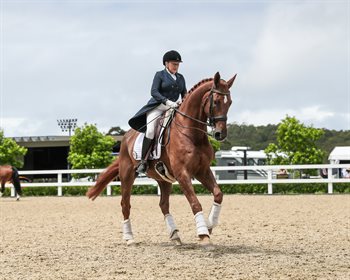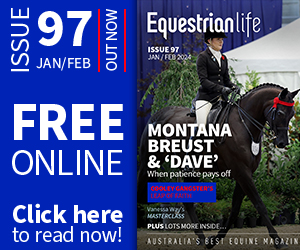|
This article first appeared in a previous edition of Equestrian Life magazine. To see what is in our latest issue, please click here.

Kerry Mack and Mayfield Limelight. Image: Amy-Sue Alston.
Go Forward!
By Kerry Mack
I really do love to use circles in my training. In a previous blog I talked about using a circle to help train the leg yielding in a way that made it easy for the horse to do the right thing, and makes it difficult to do the wrong thing. You can use a circle to help him to develop a quicker reaction from the leg to go forwards, also using the principle of making the right thing easy and the wrong thing difficult. When we are training we must first explain to the horse the reaction that we want so that he understands the aid, and only then can we develop his ability to do more. So he must understand that two legs together means GO FORWARDS.
Now some horses are willing to go forwards, horses 'with blood', a bit of thoroughbred. But some are naturally lazy and not so forward thinking. We must help these horses want to go forwards, whether they are destined for dressage, jumping or something else. All horses must want to go forwards off the leg.
One really simple exercise I like to teach him to want to go forwards from a light aid is to go from a small circle and then out forwards onto a straight line. First ask him to come on a small circle, as small as possible. He mustn't slow down too much. The circle can only be as small as he can keep his balance, no 'hand break turns'. You may need to use a touch of the whip to keep him active in the circle. It's hard work trotting actively enough around a small circle. When you feel he really wants to get out of the circle just keep him in it a few moments longer. You may need to use your outside rein and leg like a wall so that he doesn't come out of it too soon.
Then as you allow him on to the straight line you bump him sharply with your legs. GO! Legs on, legs off, quickly. First a light bump, to give him a chance to respond to the light signal,,. quickly followed by a kick, a stronger aid if he hasn't responded. It is unusual to have to need to follow it up with a tap with the whip when you ask for a bigger trot from the small circle like this. But do it if you have to.
Squeeze, kick, tap. When he reacts take the pressure off! Reward the right reaction. We are training the reaction to the leg first. When this is established we can ask for him to work harder by staying in the more energetic trot. Then of course five to seven repetitions on each rein for optimal learning efficiency.
You have two things on your side when you ask for a quick response to your leg from the circle. One is that the circle is difficult and the straight line is easy, so he wants to go forwards on the straight line, and the other is that you are essentially going from a smaller trot to a normal working trot. You are not going from working trot to a medium trot. That would be asking him to react to the leg AND work harder. A lazy horse is more likely to say No to this question, than he is if you first train the reaction to the leg by going from slow to normal. When he fully understands the reaction then you can teach him to react to the leg in the working trot to build a medium trot.
This is the learning principle of stepping stones, train the smallest possible step in the direction you are going and build on it. We know that the longest journey starts with the first small steps. Build on a strong foundation of the basic responses established and you will progress faster. Train one quality at a time. In this work we are training first the reaction (obedience) and then build more balance and suppleness by extending it.
Have Fun.
Kerry.
READ THE LATEST NEWS ARTICLES HERE

|

